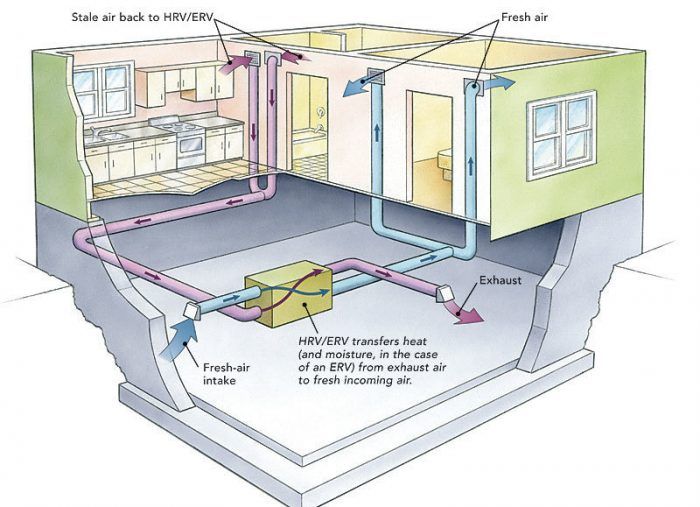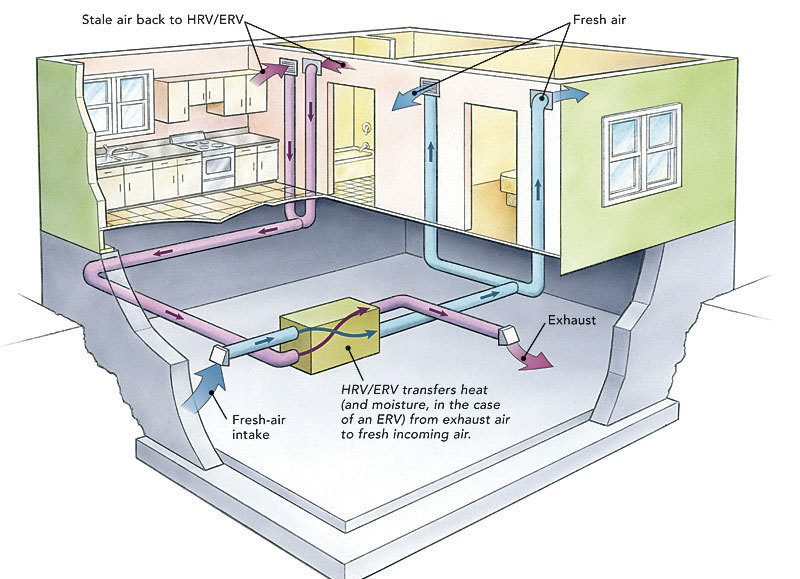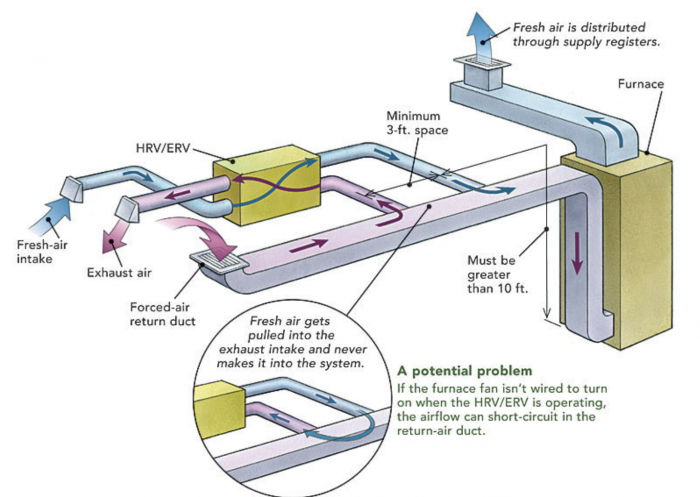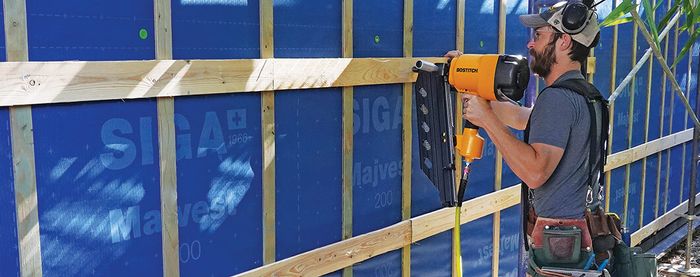Ducting HRVs and ERVs
Learn how to ensure that the ductwork for a mechanical ventilation system works efficiently to save energy and provide good indoor air quality.

Heat-recovery ventilators (HRVs) and energy-recovery ventilators (ERVs) are the most efficient devices for improving indoor air quality by supplying fresh outdoor air to a house while simultaneously exhausting stale air from inside. To increase energy efficiency, both transfer some of the heat from the warmer airstream (the exhaust stream in winter, the supply stream in summer) to the cooler airstream. ERVs also transfer moisture from the more humid airstream (the exhaust stream in winter, the supply stream in summer) to the drier airstream.
Properly installed, either one does a good job. Of course, it’s essential to follow the manufacturer’s installation instructions, but these alone are not sufficient to ensure that your system will be energy efficient and provide balanced ventilation. Unfortunately, most manufacturers permit duct configurations that can lead to very high energy bills.
Fully ducted systems are the most efficient

Dedicated supply ducts deliver fresh air to the living room and bedrooms, while exhaust ducts pull stale air from bathrooms and the kitchen. Ventilation ducts are separate from the heating-and-cooling ducts.
Of the three types of HRV/ERV installations—fully ducted systems, simplified systems, and exhaust-ducted systems—fully ducted systems are best. These systems usually pull stale air from bathrooms, laundry rooms, and kitchens. Fresh air is typically delivered to bedrooms and living rooms. With fully ducted systems, fresh air and stale air both are delivered exactly where the designer intended. These systems use less energy than systems connected to heating ductwork, and they are far easier to balance.
As with any system, duct runs should be as short and direct as possible, with a minimum of elbows or other fittings. Duct seams should be carefully sealed with mastic or HVAC tape.
Simplified systems are expensive to run
If a house already has ductwork for a heating or cooling system, it’s possible to reduce HRV/ERV installation costs by installing a system without dedicated ductwork. The least expensive approach—often called a simplified system—configures the HRV/ERV so that it pulls exhaust air from the main return duct of the forced-air system and dumps fresh air into the same duct a few feet downstream.
With this type of system, the point where the fresh-air duct joins with the return-air duct must be at least 10 ft. away from the furnace (measured along the return-air duct), and the exhaust-air connection must be at least 3 ft. upstream from the fresh-air connection.
A simplified system only works if there is an electrical interlock to turn on the furnace fan whenever the HRV/ERV is operating. If the ventilation fans operate without the furnace fan, fresh air is pulled backward toward the exhaust duct, which prevents any fresh air from entering the house.
The main problem with a simplified system is the huge energy penalty that comes from continuous operation of the furnace fan. Some furnace fans draw 800w, which can cost more than $900 per year if run continuously (in addition to the costs associated with the operation of the HRV/ERV, estimated at $200 a year or more). If the furnace has an energy-efficient blower with an electronically commutated motor (ECM), the energy penalty of continuous fan operation is reduced but not eliminated.

Exhaust-ducted systems are hybrids
An exhaust-ducted system straddles the fence between a fully ducted system and a simplified system. This installation has dedicated exhaust ductwork, but as with a simplified system, the HRV/ERV dumps the fresh air into the main return duct of the forced-air system.
With an exhaust-ducted system, an electrical interlock between the HRV/ERV fans and the furnace fan is an option. With an interlock, the system suffers from the same energy-penalty problem as a simplified system. If the fans aren’t interlocked, the ventilation system uses less energy. When the furnace is operating, fresh ventilation air is distributed through the HVAC system’s supply ducts. But when the HRV/ERV fans are operating and the furnace isn’t, distribution gets quirky, and the fresh air enters the house through the HVAC system’s returnair grilles. While this result is unconventional, the system still delivers fresh air throughout the house.
The exhaust-and supply-air flows of HRVs and ERVs need to be balanced after they are installed. This balancing process is known as commissioning. Exhaust-ducted systems without interlock wiring between the HRV/ERV and the furnace fan are particularly hard to balance because there are two different fan conditions: when the furnace fan is operating and when it isn’t. Any attempt to balance the system with dampers will only be accurate in one of these two conditions, which is another reason why fully ducted systems make the most sense.
– Martin Holladay is a senior editor.
Drawings: Don Mannes.



View Comments
Why would you ever connect an ERV with a bath room to mix the toilet smell and distribute it through out the house.
Thanks. It helped me address some of my hvac issues in my 42 year old house.
Rod, that's not how it works. It pulls the bath room air out and exhausts it to the outside. The only thing that is transferred in the ERV/HRV core is the heat. The air streams never mix.
So if you have a fully independently ducted ERV can you cut down on the number of return vents for your HVAC system, say to one large return in the middle of the house?
I have read elsewhere that HVAC systems are recommended to have multiple returns, even as much as one in each room, but that is almost certainly for a system that does not have dedicated ERV ducts.
What about connecting hrv stale air intake to return and hrv fresh air output to supply, this can run both with and without the furnace fan.
I think my ERV is ducted incorrectly. The duct in a (rarely used) bath is blowing versus pulling. The duct in the adjacent bedroom is also blowing, which I think is correct.
I'm guessing that it will be a pain in the ass to correct.